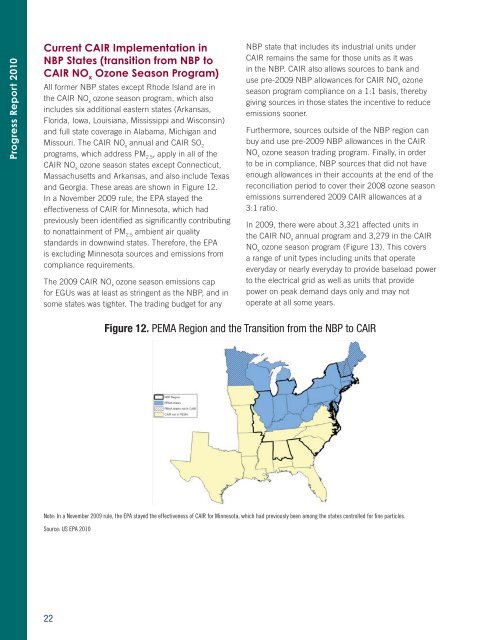2010 Progress Report - International Joint Commission
2010 Progress Report - International Joint Commission
2010 Progress Report - International Joint Commission
Create successful ePaper yourself
Turn your PDF publications into a flip-book with our unique Google optimized e-Paper software.
<strong>Progress</strong> <strong>Report</strong> <strong>2010</strong><br />
Current CAIR Implementation in<br />
NBP States (transition from NBP to<br />
CAIR NO x<br />
Ozone Season Program)<br />
All former NBP states except Rhode Island are in<br />
the CAIR NO x<br />
ozone season program, which also<br />
includes six additional eastern states (Arkansas,<br />
Florida, Iowa, Louisiana, Mississippi and Wisconsin)<br />
and full state coverage in Alabama, Michigan and<br />
Missouri. The CAIR NO x<br />
annual and CAIR SO 2<br />
programs, which address PM 2.5<br />
, apply in all of the<br />
CAIR NO x<br />
ozone season states except Connecticut,<br />
Massachusetts and Arkansas, and also include Texas<br />
and Georgia. These areas are shown in Figure 12.<br />
In a November 2009 rule, the EPA stayed the<br />
effectiveness of CAIR for Minnesota, which had<br />
previously been identifi ed as signifi cantly contributing<br />
to nonattainment of PM 2.5<br />
ambient air quality<br />
standards in downwind states. Therefore, the EPA<br />
is excluding Minnesota sources and emissions from<br />
compliance requirements.<br />
The 2009 CAIR NO x<br />
ozone season emissions cap<br />
for EGUs was at least as stringent as the NBP, and in<br />
some states was tighter. The trading budget for any<br />
NBP state that includes its industrial units under<br />
CAIR remains the same for those units as it was<br />
in the NBP. CAIR also allows sources to bank and<br />
use pre-2009 NBP allowances for CAIR NO x<br />
ozone<br />
season program compliance on a 1:1 basis, thereby<br />
giving sources in those states the incentive to reduce<br />
emissions sooner.<br />
Furthermore, sources outside of the NBP region can<br />
buy and use pre-2009 NBP allowances in the CAIR<br />
NO x<br />
ozone season trading program. Finally, in order<br />
to be in compliance, NBP sources that did not have<br />
enough allowances in their accounts at the end of the<br />
reconciliation period to cover their 2008 ozone season<br />
emissions surrendered 2009 CAIR allowances at a<br />
3:1 ratio.<br />
In 2009, there were about 3,321 affected units in<br />
the CAIR NO x<br />
annual program and 3,279 in the CAIR<br />
NO x<br />
ozone season program (Figure 13). This covers<br />
a range of unit types including units that operate<br />
everyday or nearly everyday to provide baseload power<br />
to the electrical grid as well as units that provide<br />
power on peak demand days only and may not<br />
operate at all some years.<br />
Figure 12. PEMA Region and the Transition from the NBP to CAIR<br />
Note: In a November 2009 rule, the EPA stayed the effectiveness of CAIR for Minnesota, which had previously been among the states controlled for fine particles.<br />
Source: US EPA <strong>2010</strong><br />
22
















